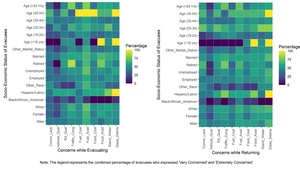1. QUESTIONS
Analyzing people’s safety perceptions during evacuation is crucial, particularly in the US, where the majority of the population resides in hurricane-prone coastal areas (Bowser and Cutter 2015). Three consecutive hurricanes made landfall in US mainland coast in the 2022 Hurricane season. On September 28th, 2022, Hurricane Ian, a category 4 storm, made landfall with 150 mph winds and a 10-15 ft storm surge, becoming the third costliest US disaster (NOAA 2022). Hurricane Ian also caused over 148 fatalities, two-third of whom were older adults (Karimiziarani and Moradkhani 2023; Palm and Bolsen 2023). A total of 2.5 million people across 12 counties were ordered to evacuate, partially due to the storm’s unpredictable trajectory (Olivo et al. 2022). Those in Lee County faced chaotic evacuation due to authorities’ late issue of evacuation orders. In this study, our main research question is: How did people in Lee County, Florida affected by Hurricane Ian perceive various safety issues involved with regards to evacuation, given the extreme uncertainty associated with the storm?
2. METHODS
For this study, we used the Pollfish online platform to survey residents of Lee County, Florida, following Hurricane Ian in January 2023. Pollfish collaborates with mobile apps to present surveys using Random Device Engagement and incentivizes responses through monetary rewards (Rothschild and Konitzer 2020). Researchers can tailor their sampling frame and recruit participants through opt-in online surveys with specific eligibility criteria.
Lee County was selected as the study area due to its direct impact from Hurricane Ian, resulting in 55 fatalities and substantial damage, especially in Fort Myers. Also, the evacuation plan prior to the storm was uncertain. Between January 7th and 28th, 2023, we conducted a survey of 100 individuals in Lee County, with no specific eligibility criteria, using a short questionnaire comprising 15 questions.
3. FINDINGS
RESPONDENT CHARACTERISTICS
This section discusses the socio-economic characteristics of survey respondents and their evacuation decisions, as presented in Table 1. Our findings demonstrate that 62% of respondents chose to evacuate following the mandatory order. The sample closely mirrored the demographic composition of Lee County. 58% of the sample comprised females, a figure in proximity to the overall female percentage of 50.7% in Lee County. Within the sample, the majority consisted of white individuals (70%), with Hispanic/Latino (13%), Black or African American (9%), and Asians (2%). Similarly, Lee County’s population was primarily composed of white individuals (86%), followed by Hispanic/Latino (24.3%), Black or African American (9.2%), and Asians (1.8%) (U.S. Census Bureau 2021). The age distribution of respondents reveals that the majority were aged over 54 years (30%) or between 35 and 44 years (25%). However, older adults exhibited lower evacuation rates, with 50% choosing to shelter in place. Lower to medium-income respondents (below $75K), constituting 61% of the sample, also had lower evacuation rates.
EVACUATION INFORMATION AND SAFETY PERCEPTION
Our analysis revealed that 62% of respondents evacuated during Hurricane Ian. The majority of those who evacuated went to the home of a friend or relative (35%) or a hotel/motel (including an Airbnb) (34%), while 22% sought refuge in a public hurricane shelter and 5% in a special needs shelter.
As for mode of transportation, 67% of evacuees used their personal vehicles, while 8% evacuated in private vehicles driven by friends or relatives. However, a very small share of people opted for alternative modes, such as ridesharing (1%), public transport (1%), cycling (1%), or walking (1%). Among the evacuees, most people (35.5%) evacuated 12-24 hours before Hurricane Ian’s landfall, while only 11.3% did so more than 24 hours before. However, 8.1% evacuated during or after the landfall, which may be attributed to a late issue of the evacuation orders (Olivo et al. 2022; Robles et al. 2022)
As part of the survey, evacuees were asked about their concerns during evacuation and when returning home. Figures 1 and 2 illustrate the concerns of evacuees while evacuating and returning during Hurricane Ian. Before hurricane landfall, people tend to panic and hoard grocery items ,causing grocery shortages and sudden price-gouging. Hurricane Ian also triggered concerns about the cost and availability of food and amenities during evacuation and upon return. Hurricane Ian raised concerns for evacuees about traffic congestion and fuel availability upon their return, as people from 12 counties attempting to leave due to a mandatory evacuation. During evacuation and return, some evacuees were deeply worried about disaster debris and standing water, which were consequences of the heavy wind and storm surge. We also investigated evacuation safety perceptions among evacuees by their socio-economic status, as shown in Figure 3.
FACTORS AFFECTING EVACUATION
Past literature indicates socio-economic and behavioral factors significantly impact evacuation decisions(Baker 1991; Karaye et al. 2022; Lazo et al. 2015). We conducted a binary logistic regression to explore factors influencing people’s evacuation decision during hurricane Ian. Ten independent variables were considered: age, gender, marital status, race, education, employment, housing type, living duration, chronic illness, and primary caregivers. The model is statistically significant and correctly classifies 74% of the data (Shown in Table 2). Additional tests, such as Hosmer and Lemeshow, Nagelkerke R2, and Cox & Snell R2, confirm a well-fitted model.
The model shows that age positively influences evacuation decisions during hurricane Ian (OR=1.039). Similarly, Hispanic/Latinos variables are statistically significant and are 6.968 times more likely to evacuate than their white counterparts. Conversely, being a primary caregiver is associated with a significantly lower likelihood (about 24.5% of the odds) of evacuating.
Retired individuals also show a negative relationship, with 0.139 times lower odds of evacuation compared to employed individuals. Finally, individuals living in the Mobile Homes and Assisted Living exhibit a significantly lower likelihood of evacuating, possibly influenced by financial or health constraints.
ACKNOWLEDGMENTS
This study was partially supported by the UF-FSU Clinical and Translational Science Award. The contents of this paper represent the authors’ opinions and do not reflect the official views of the award.






